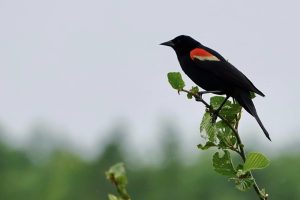 We’ve been hearing a LOT of reports of high numbers of Red-winged Blackbirds (RWBL) in the area, even in places where there aren’t any wetlands.
We’ve been hearing a LOT of reports of high numbers of Red-winged Blackbirds (RWBL) in the area, even in places where there aren’t any wetlands.
So what’s up?
Science nerd here. Bear with me…
I don’t know what’s up!
So, the first thing I wanted to do was find out if there are, in fact, more RWBL around this year, because that might influence possible explanations for the increased numbers seen.
I visited eBird, a global database managed by Cornell University’s Lab of Ornithology, which is a bird research facility that’s respected worldwide. Anyone can submit bird sightings to eBird, and the collective data over the years allows for insights into population trends, changes in species distributions over time, migration timing, etc. If you create a free account, you can contribute to this ever-growing and powerful information source or simply peruse maps and charts that summarize the data.
And that’s what I did… I checked out RWBL numbers from March through July from 2019 to 2023 for all of Ontario and within Peterborough County.
To get a sense of what might be happening, I looked at both Frequency (the % of bird lists submitted that included RWBL) and Abundance (the average number of RWBL counted in submitted lists).
It looks like RWBL Frequency and Abundance were both above average in April and May this year across Ontario and in Peterborough County, but they both dropped to average from June onwards.
What does that mean in plain English?
It seems there are indeed more RWBL around this year: more were seen in more areas this spring than in the previous 4 years. This was more pronounced in Peterborough County than Ontario-wide, which makes it even more obvious around here.
And the reduced numbers in June and July?
This might be because the numbers of people watching birds and submitting checklists was average, or even slightly below average, then… birding is generally more exciting when species return in the spring and the males are busy singing their hearts out!
So what’s up?
I still don’t know. But here’s my best guess…
The higher number of RWBL that returned from the south in April this year suggests that conditions were good on their wintering grounds (low-lying areas throughout the U.S., Mexico, and Central America, and even a bit in Southern Ontario) and more individuals survived the winter than usual.
Perhaps temperatures were warmer. Perhaps there was more food. Perhaps there were fewer predators (including humans… RWBL are considered an agricultural pest and are killed in huge numbers every year). Perhaps disease rates were lower. Perhaps more than one of these things worked together.
So, more birds arrived and populated local wetlands for the breeding season this year. It could be that there weren’t enough suitable wetlands to accommodate so many birds, and the late-arrivals or less-dominant individuals were forced to look farther afield for the summer and ended up using areas that met their minimum requirements but aren’t wetlands.
This might also explain why they’re showing up at feeders everywhere right now… there may not be enough food in the natural environment – especially the suboptimal habitats – to go around this year for all the fledglings that came from so many adults!
The cool thing about all this is that what happened here in 2022 (e.g., more food, fewer predators, etc.) could have resulted in more birds flying south from here last fall. A look at the data in eBird shows that the number of RWBL that flew south last fall was about average, which lends more strength to the theory that it was higher survival rates on the wintering grounds last winter that has so many of these bold songsters here this year.
Hope that ended up being as interesting for you as it was for me!
Andrew
Red-winged Blackbird photo: Thanks, Len Cotton!
